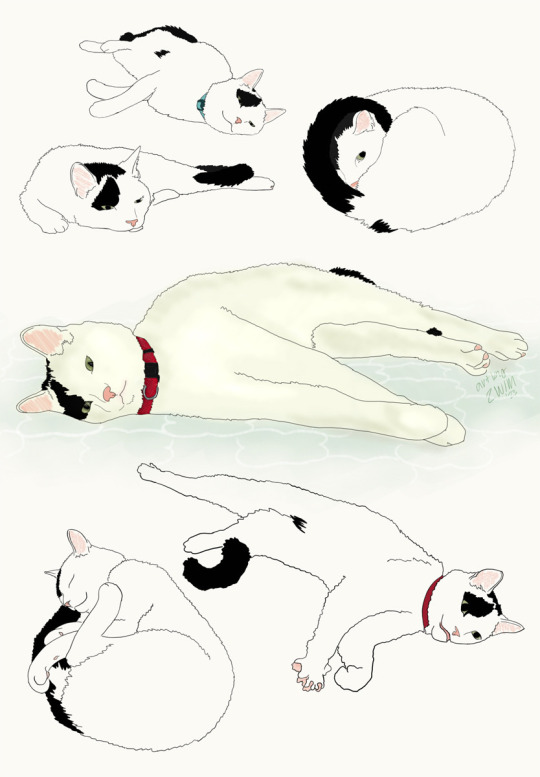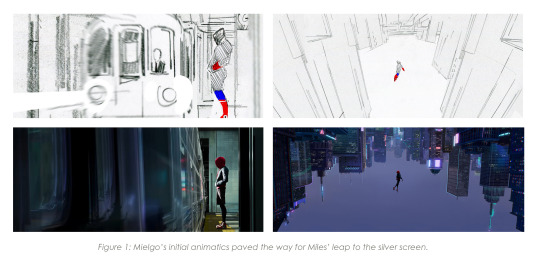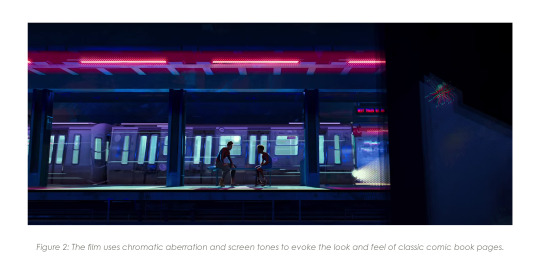#well between then and recently the wacom has made decisions to do all but work
Text

got an ipad so i had to draw my son in his many positions of rest
#patches#domestic shorthair#digital art#things i make#catblr#i got an ipad last year but took it back because my wacom had started working#well between then and recently the wacom has made decisions to do all but work#making it where i would have to go deep into the guts of my computer to delete every associated file and reinstall the driver#just to get it to work. happened multiple times and support was like ‘weird. just use this old update indefinitely’ so like. that isnt ideal#so i got an ipad (again)
7K notes
·
View notes
Photo





‘A Living Comic Book’: How Spider-Man: Into the Spider-Verse presents an alternative, experimental approach to animation and visual storytelling in modern cinema.
Directed by Bob Persichetti and written by Phil Lord, Spider-Man: Into the Spider-Verse (2018) tells the story of Miles Morales, as he picks up the mantle of Spider-Man after being bitten by a similar radioactive arachnid that once bit the original web-slinging hero, Peter Parker. The film has been praised by critics and audiences alike for a refreshing update on the superhero mythos, inspiring moral message and most importantly, an ‘entirely new’ approach to animation and visual storytelling in modern cinema (Nugent, 2019).
This essay will explore how the film adapts the language of comic books and applies this graphic-based approach to visuals and movement. The film’s use of stylistic computer-generated animation and a hand-rendered comic aesthetic effectively shapes and defines the narrative, and my investigation will attempt to represent a comprehensive study into the film’s stylistic visual language and motion.
From online discussion boards, it appears that modern day audiences feel that there is a distinctly ‘homogenized’ (Harmless, 2019) look to most digital 3D animated films, with highly detailed environments and realistic hair textures. This can be seen across a multitude of films from the last few years, including Moana (2017) and Despicable Me (2010). Tim Smith, a psychologist, states that audiences are ‘no longer won over by the spectacle of CG imagery’ (Ellison, 2019), and realistic, convincing movement.
This ‘repetitive look’ (Mielgo, 2019), is exactly what Alberto Mielgo, the original visionary behind Spider-Man: Into the Spider-Verse, was hoping to break. The veteran artist wanted to create something different from what we all generally see in mainstream animated feature films, in terms of art style and animation: to ‘explore the language of comics and cinema’ (Mielgo, 2019), and blend them together in an experimental amalgamation of graphic printing techniques and fluid, dynamic movement.
One of the film’s most defining visual features is the use of 2D illustrated lines on the computer-generated models, giving a hand-drawn charm to the project. The concept of drawn line art being placed on top of computer-generated models isn’t exactly revolutionary in itself, however. Disney did something similar and effectively pioneered the technique with the Oscar-winning Paper Man back in 2012.
Paper Man director John Kahrs saw the inherent limitation of strictly CG animation and dreamed of something different; harkening back to the animations of old: with hand-drawn, expressive lines and a charming flatness that is inherent to traditional drawn animation. He was convinced that the stylized photorealistic approach to animations like Moana (2017) can’t be ‘the only way computer animation can look’, wanting to bring the drawn line back to CG animation, and thought the hybrid process holds ‘potential’ in animated filmmaking (Robey, 2019).
By pursuing this hybrid style of 3D models and 2D overlaid elements, Into the Spider-Verse is able to take the strengths of both animation approaches and create something new and unique: a film which has the ‘rich, subtle emotive quality’ (Robey, 2019 of computer-generated animation, with an expressive line and flat visual language that makes traditionally drawn animation, and comic books, so visually engaging.
The decision to explore such an experimental approach to animation was largely that of the afore-mentioned Alberto Mielgo. If we look at the initial animatics for the film, shown in Figure 1, we can see that these early tests outlined the style of the final film: including the juxtaposition of animation with traditional comic book language, breaking shots down into panels, and incorporating other comic elements native to the medium.

As a premise, it’s one that simply couldn’t have been done in live-action film; a vibrant, striking showcase of animation and comic-inspired visuals that was, to quote animation academic Paul Wells, ‘only available’ in animation (1998, p.239). When directors take the drawn line away from the comic, the art style and very nature of the comic book itself, and simply present audiences with an actor in a superhero suit – the audience lose what makes the characters and stories so enthralling in the first place. In reference to another comic book adaption, The Mask (1994), Andrew Darley states that animated characters have an ‘element of flexibility’ within them that can be stretched ‘beyond the limitations’ of the live action actor, and so can be described as an ‘improvement’ as they allow the comic book subject matter and tone to be visualized in a way that is not hindered by realistic ‘body proportions’ of an actor (Gilmore, 2014, p.49).
To put it simply, ‘there was no better medium than animation to make a Spider-Man movie’ (Stone, 2019). Here, Persichetti illustrates animation’s unique ability to tell fantastical stories. Historically, animation has been a brilliant platform to tell stories with extraordinary elements not possible in live action. The craft itself, having the uncanny ability to breathe life into inanimate objects and illustrations, is endowed with a certain ‘magic’ (Stone, 2019) unrivalled by any other artform, allowing subject and craft to work together beautifully.
The creators wanted to make a film in which audiences could be immersed in and create a ‘living comic book’ (Wacom, 2019). This was animator Thompson on the film’s approach to visual language: a uniquely stylized aesthetic that evokes the same tactile quality of the classic comic book in which the character of Spider-Man made his debut.
This includes but is not limited to; cross-hatched textures, speech bubbles and motion lines additionally to plenty of tiny details like screen tones in shadows and illustrated onomatopoeia. With the medium of animation, the creators were able to directly draw onto each frame by hand, using the same digital drawing techniques as comic artists do.
In place of digitally-created blur effects to create depth, artists instead ‘transposed graphic printing techniques’ (Stone, 2019) to create the illusion of space and distance. In particular, the film’s use of ‘chromatic aberration’ (Adobe CC, 2019) – where the figures in the foreground appear blurred, and the colours and edges drift over one another – is drawn directly from the imperfect comic book printing techniques of the early 60s and 70s that give the illusion of blur. Shown in Figure 2, this is achieved by offsetting the red and blue values of various objects in the foreground and background, allowing the composition to have an artificial focal point.

The film is able to embrace its comic book source material and represent the character of Spider-Man up to a standard simply not possible in live action film by realizing the exaggerated character designs in animation: Into the Spider-Verse uses the fantastical nature of the medium to tell a story which could only work in animation.

Exaggerated to the point of a cartoon, central antagonist Kingpin (Figure 3) has a rectangular body and hulking stature that simply wouldn’t work translated to live action. Despite the design being drawn almost directly from the comics, having an actor look like this on screen would arguably terrify the audience. This exemplifies Wells’ suggestion that animation, as a craft, ‘seems to carry with it an inherent innocence [serving to] dilute some of its more daring imagery’ (2002, pp. 236-263). The unique language and fabricated nature of the ‘cartoon’ allows us to feel safe and comfortable whilst watching such images that would be rather disturbing if translated to live-action cinema, working on Russian philosopher Mikhail Bahktin’s concept of the ‘carnivalesque’: a ‘temporary…suspension’ of disbelief in which the usual ‘norms’ do not apply (1984, p.10).
Finally, the film’s visual language also makes use of ‘burst cards’ (Adobe CC, 2019), in which the animators drop out computer animation and present 2D, hand-drawn illustrations (Figure 4). These take a visual storytelling approach native to the comic art form, in which ‘one frame captures a strong, clear story point’ (Wacom, 2019).

Traditionally, computer animation works at the standard 24 frames per second, in which there is an image for every single frame. With this project, the creators found ‘new ways to animate’ (Stone, 2019) and ‘stripped out half of those images’ in an effort to make the movements feel ‘crisper’ and more dynamic (Adobe CC, 2019). The actual animation doesn’t flow at a consistent frame rate, either – instead, characters ‘pop’ between dynamic key poses. Action lines and hand-drawn smear frames serve as an organic way to smooth the motion, resulting in a crisp and sharp style of motion.
In this regard, Into the Spider-Verse can be considered a work of experimental animation. In his book Animation: Forms and Meaning (2002, pp.238-263), Paul Wells identifies seven ‘Signposts of Experimental Animation’, and the film adheres to a few of his criteria. With a focus on blending the language of comics and film together to evoke the feel and texture of a classic comic book, it can be described as an ‘evolution of materiality’ animation: one that uses colour, shape, and texture to evoke certain moods and give ‘pleasure in its own right’.
Until very recently, CG animation has always put a focus on fluid, smooth movement and realistic features such as hair, fur, and detailed backgrounds. The vision of an artist who despised this homogenized approach to 3D animation, Into the Spider-Verse presents a refreshingly new style of animation that a modern-day audience hasn’t seen before – shifting the focus from replicating reality to embracing the experimental ideas of graphic illustration and abstraction found in the comic book source material, dropping out entire backgrounds for striking blocks of colour and texture.
With this, Spider-Man: Into the Spider-Verse adapts a new approach to animated storytelling. With a combination of graphic printing techniques, comic book elements and a striking new approach to computer-generated animation, the creative team behind the film have managed to elevate a commercial animation feature film above its various live action counterparts. What could have been just another superhero blockbuster lost amongst the endless hordes, was instead able to present a new artistic vision of the comic book superhero: merging the language and mediums of comics and film in a way never seen before in modern cinema.
Bibliography
Adobe CC. (2019). A behind the scenes look at Spider-Man: Into the Spider-Verse | Adobe Creative Cloud. [online] Available at: https://www.youtube.com/watch?v=ektfl9rZOOA&t=13s [Accessed 30 Jan. 2019].
Bakhtin, Mikhail. Rabelais and His World. Translated by Helene Iswolsky. Indiana UP, 1984 in Threlkeld-Dent, D. Victorian Women and the Carnivalesque in Six Novels. Dissertation, Georgia State University, 2017. https://scholarworks.gsu.edu/english_diss/174
Clements, R. (dir.) (2016) Moana. [film] Walt Disney Pictures.
Coffin, P. (dir.) (2010) Despicable Me. [film] Illumination Entertainment.
Ellison, J. (2019). Here's why you don't enjoy blockbusters like you did. [online] Digital Spy. Available at: https://www.digitalspy.com/movies/a827565/heres-why-you-dont-enjoy-blockbusters-like-you-used-to/ [Accessed 4 Feb. 2019].
Gilmore, J. and Stork, M. (2014) Superhero Synergies : Comic Book Characters Go Digital. Lanham, Maryland: Rowman & Littlefield Publishers.
Harmless, M. (2019). Will there be a CG Animation with a serious mature story?. [online] CGTalk. Available at: http://forums.cgsociety.org/t/will-there-be-a-cg-animation-with-a-seroius-mature-story/1680281/4 [Accessed 3 Feb. 2019].
Howard, W. (2019). The Genius Animation Behind Spider-man: Into the Spider-Verse | Analysis. [online] YouTube. Available at: https://www.youtube.com/watch?v=N21oG99eF3A&t=1192s [Accessed 31 Jan. 2019]
Kahrs, J. (dir) (2012) Paperman. [film] Walt Disney Animation Studios.
Maniakra. (2019). ART BREAK DOWN of SPIDER-MAN: Into the Spider-Verse (Part 2). [online] Available at: https://www.youtube.com/watch?v=POZJGqwT-yA&t=210s [Accessed 29 Jan. 2019].
Mielgo, A. (2019). STORYBOARDS-SPIDERVERSE-ALBERTO MIELGO. [online] Vimeo. Available at: https://vimeo.com/311716775 [Accessed 1 Feb. 2019].
Mielgo, A. (2019). Spiderman — +. [online] +. Available at: http://www.albertomielgo.com/spiderman/2018/12/19/d9zhz04jz8ddc22m0rcduzm56vw4fd [Accessed 1 Feb. 2019].
Murphy, M. (2019). ‘Spider-Man: Into the Spider-Verse’ and How a Scene Crawled to Life | Anatomy of a Scene. [online] YouTube. Available at: https://www.youtube.com/watch?v=BULa8qozTyo [Accessed 2 Feb. 2019].
Nugent, J. (2019). Spider-Man: Into The Spider-Verse. [online] Empire. Available at: https://www.empireonline.com/movies/spider-man-spider-verse/review/ [Accessed 4 Feb. 2019].
Robey, T. (2019). Paperman is the best thing Disney has done in years. [online] Telegraph.co.uk. Available at: https://www.telegraph.co.uk/culture/film/film-news/9839322/Paperman-is-the-best-thing-Disney-has-done-in-years.html [Accessed 29 Jan. 2019].
Russel, C. (dir.) (1994) The Mask. [film] New Line Productions.
Ramsey, P. (dir.) (2018) Spider-Man: Into the Spider-Verse. (2018). Sony Pictures Animation.
Stone, T. (2019). Behind the Scenes of the Spider-Verse | Create. [online] Create.adobe.com. Available at: https://create.adobe.com/2018/10/15/behind_the_scenes_of.html [Accessed 2 Feb. 2019].
Wacom. (2019). Wacom into the Spider-Verse. [online] Available at: https://www.youtube.com/watch?v=fol6jq2KOsc [Accessed 4 Feb. 2019].
Wells, P (1998) Understanding Animation. New York: Routledge.
Wells, P. (2002) Animation: Forms and Meaning in Nelmes, J. (ed.) An Introduction to Film Studies. 2nd edn. London: Routledge.
Zahed, R. (2018). Spider-man: Into the Spider-Verse - The Art of the Movie. New York: Titan.
0 notes